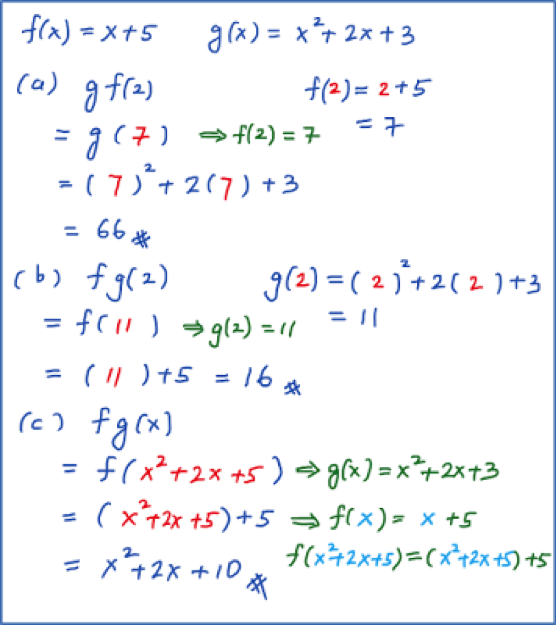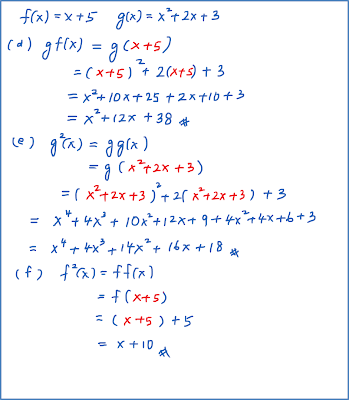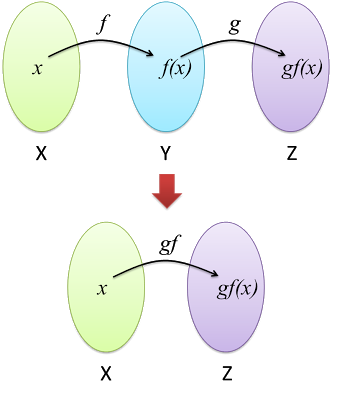Monthly Archives: April 2020
Example 3
Example 2
Given f:x↦1−x and g:x↦px2+q. If the composite function gf is defined by gf:x↦3x2−6x+5, find
- the value of p and of q,
- the value of g2(−1).

Example 2
Example 1
If f : x → x + 5 and g : x → x2 +2x + 3, find
- the value of gf (2),
- the value of fg (2 ),
- the composite functions fg,
- the composite functions gf,
- the composite functions g2 ,
- the composite functions f2.

correction for part (c)
fg(x)=f(x2+2x+3)=(x2+2x+3)+5=x2+2x+3+5=x2+2x+8

1.3a Composite Function
Composite Function
If function
f:X↦Y
,
and function g:Y↦Z ,
hence, composite function gf:X↦Z
and function g:Y↦Z ,
hence, composite function gf:X↦Z

Example:
If, f:x↦2x+5 and g:x↦x2−1 , find gf(2)
Answer:
f(x)=2x+5f(2)=2(2)+5=9
gf(2)=g[f(2)]=g(9)
g(x)=x2−1gf(2)=g(9)=92−1=80
If, f:x↦2x+5 and g:x↦x2−1 , find gf(2)
Answer:
f(x)=2x+5f(2)=2(2)+5=9
gf(2)=g[f(2)]=g(9)
g(x)=x2−1gf(2)=g(9)=92−1=80
Example 4 and 5
Example 2 and 3
Domain, Range, Objects, Images and Absolute Value Functions
(B) Domain, Range, Objects and Images of a Function
Example:

The arrow diagram above represents the function f : x → 2x2 – 5. State
(a) the domain,
(b) the range,
(c) the image of –2,
(d) the objects of
(i) –3,
(ii) –5.
Solution:
(a) Domain = {–2, –1, 0, 1, 2}.
(b) Range = {–5, –3, 3}.
(c) The image of –2 is 3.
(d) (i) The objects of –3 are 1 and –1.
(d) (ii) The objects of –5 is 0.
Example:

The arrow diagram above represents the function f : x → 2x2 – 5. State
(a) the domain,
(b) the range,
(c) the image of –2,
(d) the objects of
(i) –3,
(ii) –5.
Solution:
(a) Domain = {–2, –1, 0, 1, 2}.
(b) Range = {–5, –3, 3}.
(c) The image of –2 is 3.
(d) (i) The objects of –3 are 1 and –1.
(d) (ii) The objects of –5 is 0.
(C) Absolute Value Functions
1. Symbol | | is read as ‘the modulus’ of a number. In general, the modulus of x, that is | x |, is defined as
|x|={x if x≥0−x if x<0
2. In other words, modulus of a number always positive.
3. The absolute value function | f(x) | is defined by
|f(x)|={f(x) if f(x)≥0−f(x) if f(x)<0
Solution:
(a)
Given f (x) = |x + 2|
Image of –4 is f(–4) = | –4 + 2| = | –2| = 2
Image of –3 is f(–3) = | –3 + 2| = | –1| = 1
Image of 0 is f(0) = | 0 + 2| = | 2 | = 2
Image of 2 is f(2) = | 2 + 2| = | 4 | = 4
(b)
From (a),
f(–4) = 2
f(–3) = 1
f(0) = 2
f(2) = 4
Determine the point where the graph touches the x-axis.
At x-axis, f (x) = 0
|x + 2| = 0
x + 2 = 0
x = –2

Therefore, range of values of f (x) is 0 ≤ f (x) ≤ 4.
1. Symbol | | is read as ‘the modulus’ of a number. In general, the modulus of x, that is | x |, is defined as
|x|={x if x≥0−x if x<0
2. In other words, modulus of a number always positive.
3. The absolute value function | f(x) | is defined by
|f(x)|={f(x) if f(x)≥0−f(x) if f(x)<0
Example:
Given function f : x → |x + 2|.
(a) Find the image of –4, –3, 0 and 2.
(b) Sketch the graph of f (x) for the domain –4 ≤ x ≤ 2.
Hence, state the range of values of f (x) based on the given domain.
Solution:
(a)
Given f (x) = |x + 2|
Image of –4 is f(–4) = | –4 + 2| = | –2| = 2
Image of –3 is f(–3) = | –3 + 2| = | –1| = 1
Image of 0 is f(0) = | 0 + 2| = | 2 | = 2
Image of 2 is f(2) = | 2 + 2| = | 4 | = 4
(b)
From (a),
f(–4) = 2
f(–3) = 1
f(0) = 2
f(2) = 4
Determine the point where the graph touches the x-axis.
At x-axis, f (x) = 0
|x + 2| = 0
x + 2 = 0
x = –2

Therefore, range of values of f (x) is 0 ≤ f (x) ≤ 4.
Notation of Function
As shown in figure above, for a function
f:X→Y
, each element x in the domain X has a unique image y in the codomain Y.
The function can be written as:
y=f(x)orf:x↦f(x)
- For y=f(x) , we say y is a function of x.
- f(x) is also called the value of the function f at x.
- f(x) is read as "f of x".
Example:
Given the function f:x↦5x+1 , find the value of
a. f(2)
b. f(−3)
c. f(25)
Answer:
(a)
f(x)=5x+1f(2)=5(2)+1=11
(b)
f(x)=5x+1f(−3)=5(−3)+1=−14
(c)
f(x)=5x+1f(25)=5(25)+1=3
Given the function f:x↦5x+1 , find the value of
a. f(2)
b. f(−3)
c. f(25)
Answer:
(a)
f(x)=5x+1f(2)=5(2)+1=11
(b)
f(x)=5x+1f(−3)=5(−3)+1=−14
(c)
f(x)=5x+1f(25)=5(25)+1=3








